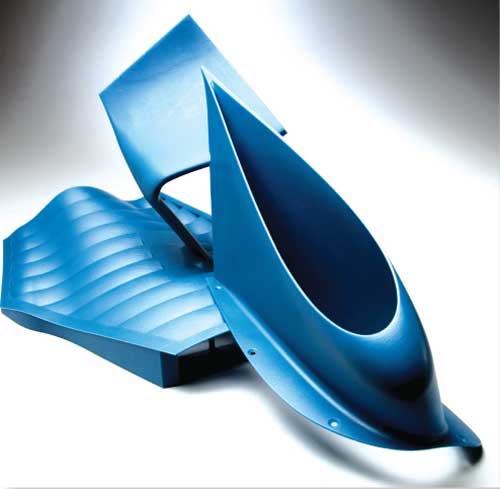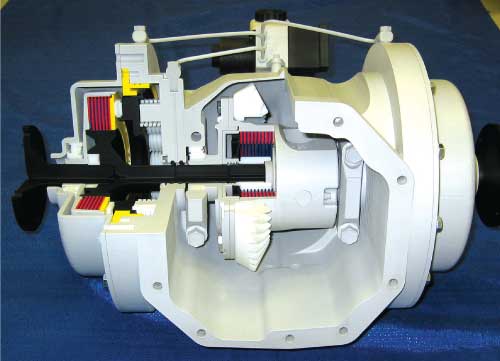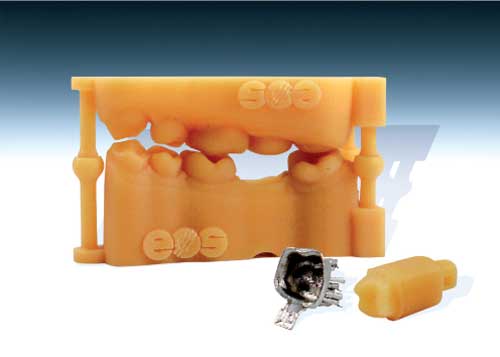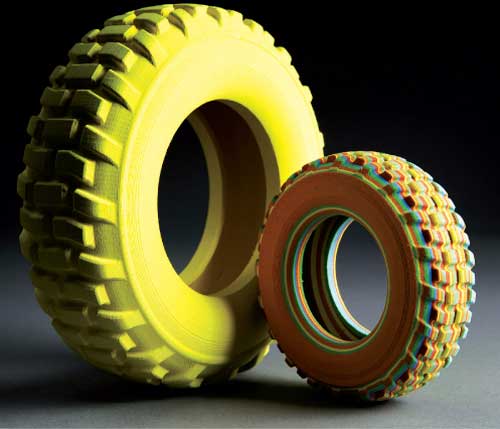The Value of Color
DE looks at a range of vendor options that create direct-from-the-system color parts beyond the classic white, off-white and clear results.
Latest News
September 1, 2011
By Pamela J. Waterman
Most people can tell you the exact scene in the 1939 film The Wizard of Oz when the production switches from sepia/black-and-white to full Technicolor. That stunning achievement was the result of switching out physical film types to run three different strips, sensitized to red, green and blue, through one large camera at the same time.
Switching from black-and-white to color in today's world of rapid manufacturing technologies, particularly in additive manufacturing (AM), can be a much less labor-intensive job.
Why Color?
“Most 3D printing and rapid prototyping technologies work in monochrome, where only one color is used “and that is the base color of the material,” says Joe Titlow, vice president of product management for Z Corp. “The definitions of what it means to print 'in color' differ widely between technologies.”

F1 racecar parts were built in high temperature Accura Bluestone composite
resin on a 3D Systems SLA machine. Image courtesy 3D Systems.
If you're talking Technicolor AM, Z Corp. equipment leads the pack. But life is always full of trade-offs; Z Corp. materials are targeted to the visual and prototyping markets, and may not have the strength or surface finish needed for certain applications. Other vendors, such as Stratasys, envisionTEC, 3D Systems and Objet Geometries, offer dozens of materials with enhanced properties such as superior stiffness or high heat deflection temperature, but only come in single-color materials with a few multi-color variations.
But why color in the first place? Titlow says the benefits possible with color cover a wide range that not everyone sees when first evaluating AM systems. For example, users can create individual parts (each a different color), assemble them and clearly differentiate each part within an assembly. Some color systems can handle two colors on a single part to create a label, complete with text “or to differentiate a small section from a larger one.
Look beyond these uses, and color also offers new ways of viewing traditional models and data. A system that can create photorealistic color variations across a build volume opens up the manufacturing world to final-appearance prototype parts and packaging designs. It supports architects, urban planners, scientists and health professionals with full-color 3D models depicting buildings, geographic information and CAT scans. And it offers a truly 3D approach to viewing stress or temperature variations analyzed with FEA or CFD software.
Full Spectrum of Color Options
Z Corp. offers five models in its 3D ZPrinter line, three of which build parts with fully ranging colors. Standard 24-bit HP color-inkjet printer heads mix cyan, magenta, yellow, black and white inks into a clear binder-fluid. Done on the fly during printing, this approach offers a natural set-up for applying more than 390,000 different colors within each layer of the powdered, plaster-like base material.
The resulting pixel-level color variations help Z Corp. customers convey complex information to potential clients in many ways. For Stanley Black & Decker, this approach lets designers generate concept prototypes without computed numerically controlled (CNC) machining or time-consuming hand-painted detailing. Models can be turned around in 48 hours, enabling more concept-model generation earlier in the development cycle.

Designers at Dana Corporation created the 3D CAD model of an automotive
clutch assembly and then built the corresponding physical model, assembled from
parts made in different colors on a Stratasys Fortus AM system.
Images courtesy Stratasys and Dana Corporation.
From another point of view, Z Corp. customer Hydroforming Design Light AB finds color is critical for demonstrating the value of hydroforming to potential clients. Compared to drawing or stamping, the process uses pressurized water to expand aluminum or steel into molds. Its consistent, even force minimizes weaknesses in finished parts, but it is a more expensive process. Z Corp.-printed parts have replaced PowerPoint slides for communicating the details of finite element analysis (FEA)-determined stress levels across part geometry. The color variations clearly show how hydroforming avoids manufacturing problems.
A very different AM technology, fused deposition modeling (FDM), builds up parts from actual industrial thermoplastics delivered to the equipment as pure-color filaments. Developed by Stratasys, FDM operates across a broad line of systems, creating durable parts suitable for functional testing and end-use.
The Stratasys Fortus production systems can run with nine different thermoplastics, optimized for various properties such as tensile strength or flame/smoke/toxicity certification. Three of these are variations of acrylonitrile butadiene styrene (ABS) plastics that come either in solid colors such as black, dark gray, red, blue, olive green, nectarine and fluorescent yellow (as well as ivory), or translucent versions of red, amber and natural.
|
Color via Consumer Demand Dassault Syst mes 3DVIA design software subsidiary has teamed up with service bureau Sculpteo to 3D print anyone's design through an online service. Parts can be built in white or black plastic on Sculpteo's in-house EOS Formiga P100 system (example price $42 for a 2-inch part) or in full color on the company's ZCorp 650 3D Printer (example price $48 for a 2-inch part). For a stand-out variation on classic photography, 3DPhotoWorks can take a 2D color digital image and give the image a dimensional feel. The process uses a computer algorithm to separate various aspects of the data, create a bas-relief substrate with a depth up to 1.75 inches and print the image on the raised shape. |
By building parts from different colors (switching out the color reel each time), designers can put together assemblies where each part clearly stands out. This type of application is useful for Stratasys customer Dana Holding Corp., a Tier I automotive supplier whose products include cooling systems, differential cases and under-the-hood filtration systems.
“During the design stage, we add colors to the components of assemblies (such as an automotive clutch),” says Bruce Vanisacker, designer for Dana's Rapid Prototyping/CAE Services. “Then we build FDM prototypes in the same colors.”
The Fortus parts help the designers visualize whether assemblies meet key form and fit requirements. In some cases, adds Vanisacker, the parts are so strong they can be used for performance evaluation, too.
envisionTEC is a German AM company with a strong presence in the dental and jewelry industries. Its photopolymerization process, based on mask projection using Digital Light Processing (DLP) technology, takes a different approach than SL to solidifying layers of photosensitive resins. Materials for the company's Perfactory and Ultra systems include a number of color options with varying material properties.
Color Me Innovative
From here on, the actual colors for a given system tend to be secondary to material properties, but still yield some interesting results, particularly in the case of Objet Geometries.

This dental model was laser-sintered on the FORMIGA P 100, and the
metal crown shown was produced using the EOSINT M 270. The model
was made in PA 2105, a colored polyamide that offers color contrast with
dental prostheses, making the veneering process easier. Image courtesy EOS.
Objet's PolyJet systems operate by jetting photopolymer materials in ultra-thin layers onto a build tray, with each layer cured by UV light immediately afterward. For the company's line of Connex 3D Printing systems, a dual-jet operation lets users fabricate composite on the fly. This PolyJet Matrix process simultaneously jets two proprietary materials chosen from 14 different base materials (of the same type/different color or different types) and combines them in specific concentrations.
The result is 51 possible “digital materials” whose properties vary in flexibility, hardness, temperature-handling and toughness. Although Objet says the company is focused more on these aspects than color, transparency and opacity, the approach does let users create parts with some creative variety. Because the various base materials come in blue, black, white and transparent, different combinations can produce 11 shades of gray, artistic patterns, rubbery soft-touch sections and even color-transparent areas.
Not surprisingly, the broad line of equipment from 3D Systems can build parts in quite a few different colors besides white “but again, it's pretty much a case of one color per material. For example, depending on the stiffness you need, photopolymer resin options for stereolithography (SLA) equipment include gray, opaque gray, blue, peach or light green.
3D Systems Multi-Jet-Modeling 3D Printers offer the VisiJet line of acrylic plastics in blue, gray, dark blue and dark green “each with its own values for tensile strength, flexural strength and elongation at break. And the company's selective laser sintering (SLS) systems create plastic parts in black and gray, depending on whether you choose the ABS-like DuraForm EX or DuraForm GF (glass-filled) options.
In the realm of rapid subtractive manufacturing, Roland DGA remains a cost-effective player for applications without internal geometries and where true end-materials are desired. Color choice is up to you when you use, for example, actual ABS plastic stock on the company's MDX-540 desktop milling machine.
Variations on a Color Theme
For several vendors' systems, third-party sources develop and market dozens of compatible materials that give users more choices for final properties; several of these come in colors.
EOS markets AM systems that sinter either plastic or metal powdered materials. In 2009, the company took majority ownership in Advanced Laser Materials, a Texas business dedicated to invigorating the development of powder-based AM materials. ALM President Donnie Vanelli says that achieving color can be a challenge for sintering systems, because you basically blend white nylon 12 with black carbon filler: “The result is more of a salt-and-pepper effect, giving the material a dark gray look.”

These miniature “tires” are examples of color (solid and striped) parts built
by using layers of colored paper in an Mcor Technologies Matrix system.
Parts are approximately 3 in. and 1.5 in. diameter. Image courtesy Mcor Technologies.
ALM also offers 605A, an aluminum-filled nylon similar to EOS' alumide material. What's special is that polishing one of these parts creates an appearance almost like metal. In addition, ALM just announced the availability of its own 850 Black material, a straight black nylon with the pigment in the powder itself.
|
Color off the Beaten Path Color options are not the exclusive realm of industrial AM systems. 3D Systems is the new owner of the RapMan Kit (do-it-yourself) and BfB3000 (assembled) systems developed by Bits from Bytes. These AM systems deposit melted plastics through a heated nozzle (double and triple nozzle upgrades available). Biodegradeable poly lactic acid filament stock comes in solid black, white, purple, yellow, blue and green and translucent clear, red, blue and green. ABS material is available in white, black, red, blue, green and yellow. Mcor Technologies is a growing presence with its plain-paper lamination system. You can load the unit with stacks of colored paper per your desired design and generate functional striped parts. Chefs at the French Culinary Institute in NYC have been experimenting with two generations of Fab@Home AM systems, using liquid and paste versions of frosting and other foods, while a group at the University of Exeter have been focusing on printing in chocolate. |
Huntsman is an international business whose Advanced Materials division is heavily invested in formulating SLA resins for easy processing, high throughput and a range of mechanical properties. Its RenShape SL line includes SL 7820, which produces dark-brown to black parts, while two of the materials listed as medical grade support “selective coloring” (more about that later).
DSM Somos is another material supplier for SL systems. The company has been involved in this field since the early 1980s, paralleling the development of 3D Systems' equipment. Nearly two dozen material options are offered, each with properties that give SLA users more choices for their specific system and application needs.
Among these are DSM Somos ProtoTherm 12110, a high-temperature, water-resistant resin that happens to be cherry red, and ProtoGen 18920, which creates gray ABS-like parts and exhibits different material properties depending on machine exposure control.
Speaking of control, engineers are often at their best trying to push the standard operational limits of a given piece of equipment. This fact is evidenced by a recent online discussion within the Additive Manufacturing Users Group on LinkedIn.
SLA system users compared notes on how to darken a precisely defined section of an SLA part during the build process to highlight an internal detail. The approach is to vary the laser exposure-time in that area; the trick is to do so without distorting, melting or charring the part. Suggestions included running a fan directly across the build layer and always exposing the smaller area first to give a double-exposure more time to cool down.
Huntsman's RenShape SL H-C 9100 and Y-C 9300 resins are designed for just such specialized laser applications. Normally clear, the areas on a layer where users selectively target more energy turn violet in color; the two versions are optimized for different wavelength laser sources.
Color Footnotes
No discussion of color in rapid manufacturing is complete without mentioning two other aspects of the topic: casting and post-processing. First, systems from Solidscape (now part of Stratasys), envisionTEC, 3D Systems and Roland DGA run materials in impressive colors ranging from clear, vivid purple to deep amber to photosilver. However, the resulting parts are “just” models for lost-wax casting or producing rubber molds; they're not seen by the end consumer.
Second, most AM parts can be post-processed with surface color by dyeing, impregnating or painting some or all of a part or assembly.
And for a third possibility, Roland DGA markets the VersaUV LEF-12, an interesting inkjet overprinting system that applies CAD-directed, 6-color imagery directly onto the surface of 3D parts as thick as 3.94 in.
If only Turner Entertainment had it this easy.
For More Information:
Contributing Editor Pamela Waterman, DE's simulation expert, is an electrical engineer and freelance technical writer based in Arizona. You can send her e-mail to [email protected].
Subscribe to our FREE magazine, FREE email newsletters or both!
Latest News
About the Author
Pamela Waterman worked as Digital Engineering’s contributing editor for two decades. Contact her via .(JavaScript must be enabled to view this email address).
Follow DE





